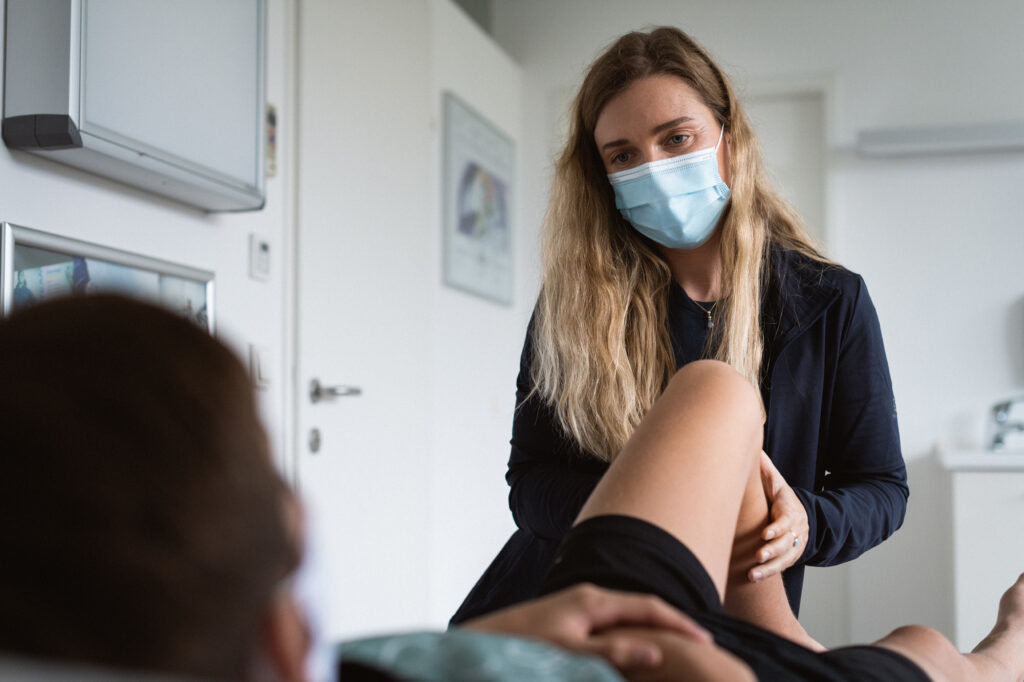My knee always buckles – Anterior cruciate ligament rupture in children
Falling on your back on a slab of ice during a school ski course, being pushed and tripping while playing catch during recess, fighting too hard for the ball during a football game – there are so many ways that a child might tear a cruciate ligament in the blink of an eye.
Following the initial pain and swelling of the knee joint, children often recover relatively quickly after a knee injury. Regardless, childhood joint effusion is not a trivial matter. If the knee gives out, its definitely a serious matter that should be absolutely examined by a doctor. After all, the consequences of an unstable knee joint are clearly more serious than those of a bone fracture. The latter heals with high probability without long-term consequences, while permanent instability after a rupture of the anterior cruciate ligament can cause the development of early arthrosis.
In the last few decades, the proportion of children and adolescents with cruciate ligament ruptures has increased. This is certainly due in part to better diagnostics, but it is also due to the fact that children in particular sports start one-dimensional training progammes earlier than ever before. The risk factors that lead to anterior cruciate ligament injury in childhood are at least as ill-defined as those in adulthood. It has been established that boys have a slightly higher risk in early childhood. Meanwhile, girls are at higher risk during and immediately after puberty.
To operate or not to operate – that is the question

It is assumed that 50 out of 100,000 children who are active in sports tear their cruciate ligament at least once. This presents the medical profession with a dilemma: to operate or not to operate? The question is difficult because the growth plates in a child’s knee are still open and an injury during the course of the operation can lead to growth disturbances. For this reason, today and in the past, many operations were postponed for a long time with the recommendation to avoid risky sports. But is it realistic to tell a child that quick changes of direction, contact sports, and stop-and-go movements are off limits?
The implementation of all this is possible, but it does mean being excluded from gymnastic lessons, sometimes even music lessons, the inability to participate in various activities during recess in the school yard, and also not participating in nearly any recreational activities outside of school. Such activities are a normal part of childhood! The absolute minimisation of risk leads to social isolation for children and and is therefore not the preferred accepted solution on behalf of the child. Often, an unstable knee joint at a young age may result in meniscus or cartilage damage. This is not to say that conservative management with physiotherapy and waiting and see is wrong in principle. However, it requires close monitoring to prevent additional complications. Therefore, the current tendency rather favours having an early operation “with special consideration given to protecting the growth plates.” This means that a child cannot be operated on in the same way as an adult. If possible, a specialist in knee surgery with experience in childhood cruciate ligament surgery should perform the procedure.
PAMI study to improve treatment
With the aim of improving treatment and observing in which cases a preventive approach is possible and sensible, the Gelenkpunkt medical practice is taking part in an observational study on childhood cruciate ligament injuries (PAMI). As part of this monitoring initiative, data from across Europe will be fed into a register established in 2018 by ESSKA, the European Society of Sports Traumatology, Knee Surgery and Arthroscopy. After anterior cruciate ligament surgery, children are monitored until growth is complete. The data collected is then collated and entered anonymously into the European database. Of course, participation is voluntary and requires the consent of the child concerned and his or her parents.
The goal of this initiative is not only to improve treatment but also to find out how preventive measures can best be introduced, how often growth disturbances actually occur, how child-specific rehabilitation programs should be designed, and how the risk of re-injury can be minimised.
The goal of this study is not only to improve treatment but also to find out howpreventive measures can best be introduced, how often growth disturbances actually occur, how child-specific rehabilitation programmes should be designed, and how the risk of re-injury can be minimised.
Adapting treatment to skeletal maturity
In post-operative therapy, physiotherapy also makes a clear distinction between children and adults. For example, the way in which forms of movement are instructed or carried out, dealing with additional weight in training, education, self-management and responsibility are all different.. Children need more care and support from their caregivers in this regard.
The content of the therapy must be adapted to the physical and psychological maturity of the child. In school-age children (seven to twelve years), therapeutic exercises should be playful, varied and carried out using the child’s own body weight only. Parents should be involved in the exercise process to support the children concerning the technical implementation and the consistent execution of the exercises. During adolescence (twelve to 18 years), children can be expect to increasingly perform high quality movements. With the onset of skeletal maturity, supplemental weight training is often incorporated.
Children are at increased risk of rerupture, so a child’s return to sports after anterior cruciate ligament injury should be slow, cautious, and occur later than in adults. The end of rehabilitation is also the beginning of secondary prevention. Carrying out consistent strengthening exercises for the trunk and leg muscles as well as implementing coordination, jumping and running training as part of the warm-up programme for the team or individual training have all been proven to reduce the risk of re-injury. The focus here should be on clean movement quality.